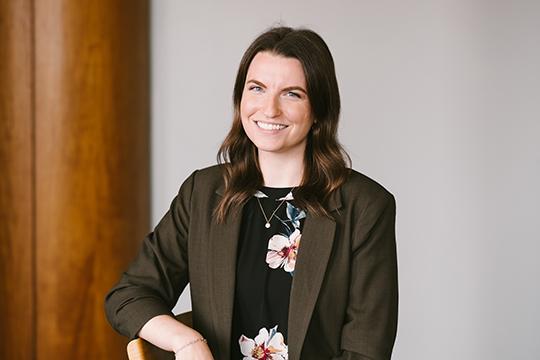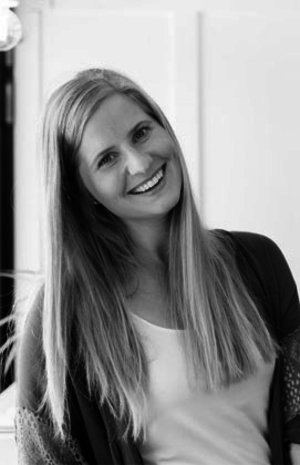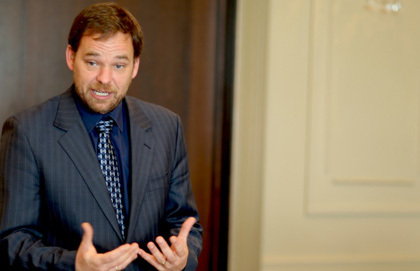Convivium: How did the initiative Free To Be evolve? Can you share how the experiences you had growing up that gave you a heart for talking about positive body image with teens and pre-teens?
Renae Regehr: Free To Be started as a blog. I was driving home from school one day in October, and I heard a DJ on the radio say: "Aren't you glad that it's sweater season so we can start to hide our bodies again?" All the other DJs laughed. I turned off the radio immediately. I was indignant; it was like the last straw that broke me. I thought to myself, it’s no wonder that we feel so insecure growing up when we hear messages like this all the time.
I was so fired up that I wrote a blog post. I used that blog to share about what I was learning throughout my Master's Degree in Counselling Psychology. I was researching representations of men and women in media, and how that was impacting the viewer’s attitudes about their identity.
Soon after, I had an opportunity to run a body image group with a friend who was a youth care worker. I developed a rudimentary curriculum out of my research so we invited Grade 6 and Grade 7 girls to a body image group during their lunch hour at the school we worked at. It was so eye-opening because the same insecurities that I had as a teen, 10-15 years earlier, were coming up again from these young girls. I was surprised again and again at all the pressures they had around them, especially from social media, telling them that they weren't enough, and telling them how they should feel.
I started a literature review to potentially create a real curriculum for a body image program as my thesis. In my research, I saw the need to come from a strengths perspective, where we aren't just focusing on what is a problem, but more “what do we do now?” After we deconstruct everything we need to provide people with a roadmap or solutions about what to do and where to go.
As the blog I started evolved and became the subject of my thesis, I thought, “I can do this on a larger scale.” So it became what is now called Free To Be and, just this past year, we became an official non-profit organization. It's really been quite an evolution.
Having a program like this when I was growing up would have changed my trajectory a lot. I really struggled with body image as a teen, so being able to have had this knowledge-- these tools, these skills-- would have been so helpful in understanding the smoke screen of the media. As bodies start to change around 11, 12, and 13 being able to understand that the media isn't a reflection of reality and how we can understand and critique the deeper messages behind it is so important. I wish I had known all this when I was younger, and that's a huge reason – the initial reason – I created the program.
Convivium: At Free to Be Talks, you “imagine a world where boys and girls grow up to see multi-dimensional, holistic, and healthy portrayals of what it means to be a man or woman.” What does – and doesn’t – that look like? How does it look in a person of faith trying to live this way?
RR: Often on social media we just see a sliver of who a person is. If we see only that version of others repeatedly, it can really shortchange us into believing ‘this is who I should be.’
Free To Be is meant to encourage us to recognize that we are whole people. Our bodies are not the only “good” thing about us. We have passions, we have ideas, we have imaginations, we have ambitions, we have emotions. We are whole people.
What we do on our social media pages is promote people who are doing really cool things that highlight different parts of their person. God has made us as rich vessels with so much to contribute and create.
Convivium: The Free to Be Talks social media pages continue to promote ideas and conversations around having a positive body image and how that contributes to confidence and developing leadership skills. With its heavy influence on the minds of young people, do you see social media being a successful tool to accomplish this?
RR: You can use it to connect with like-minded communities, where people share similar beliefs. You're able to exchange ideas and engage with a community of people who are similar to you.
On the flip side, social media is evolving with highly complicated algorithms and artificial intelligence – even using neuroscience to make apps incredibly addictive. It’s so difficult to step away from social media. I use it with Free To Be for spreading positive messages, but I only post three to four days a week. We should watch that we’re not getting trapped in the cycle of counting likes, or gaining followers, or seeing comments on what we’re posting.
I have a really strong support system around me, but for someone who is younger, they have certain vulnerabilities. When they're feeling alone, or insecure, or they've had a really tough day at school, the validation that comes from the likes and comments feels so good. It’s a really dangerous place to be in because it can be so hollow.
Convivium: In your experience working with different cohorts in public schools, do you think growing up with the influence of a church community makes a difference in the body image in a young person?
RR: When you research the predictive factors in promoting a positive body image, one is a belief that there's a higher power that has made you inherently unique, inherently special, inherently valuable. I absolutely believe that growing up in a church, having that deeper faith that grounds you in who you are and why you are special, is absolutely a protective factor in developing or promoting a positive body image.
However, we don't live in bubbles. All kinds of kids, wherever they are, whether in school or at church, are surrounded by messages from all over the place, whether on YouTube or Netflix or walking around the mall. The church is definitely a protective factor, but we need to remember that kids in church or youth group are just as susceptible to feeling these insecurities as those without those deeper faith beliefs rooting them in why they are special or why they are valuable.
Convivium: Do you find it's easy for you to bring in the faith aspect of your passions for this program? What’s the faith culture like in your workplace?
RR: Free to Be is a network across the Lower Mainland and the Fraser Valley in B.C., and we’ve now expanded into some U.S. cities such as Boston and New Hampshire and several other places. It was my dream, when I developed the program, to have a team around me to make it more widely available and accessible across North America. It’s now a licensed program that’s designed for teachers or counselors or community leaders so they can run it in their schools and their communities.
Because of this broad network, and because we’re working in the public school system, I can't explicitly bring God into Free To Be Talks. But what I tell people, and what my close family and friends know, is that Free To Be was grown in the soil of my faith. Everything that has come from Free To Be comes from my philosophical viewpoint of who I believe God has created us to be. It puts an emphasis on gratitude, on critical thinking, on the collective community, and on identifying our strengths. I don't see it as being separate from my faith, but rather a fruit of it.
CM: As the founder of Free to Be, what kind of a theology of the body has your work developed for you personally?
RR: I grew up in a family that has really strong faith. Deep questions and conversations were not only welcome, they were highly encouraged and a part of our dinner table conversations. I felt like I was a ‘whole person’ growing up. My parents really praised and valued my internal characteristics. They were really open about talking about puberty and the changes in our bodies. Our bodies were always something that were celebrated, and never something I felt ashamed of or anything like that. But as a teen – like most people, I didn't live under a rock – I naturally became highly aware of what society valued. And I didn't have the tools to understand what I was seeing around me in terms of deeper messaging from the media. I started to believe that my appearance was this ticket that was going to unlock all these opportunities for me, that it was going to give me a platform, that it would make me feel special, that I would feel like I was enough. Of course, if you told me that explicitly I would have said, “You're out to lunch!" but looking back, I can absolutely see that's what I was believing.
Then in my 20's I watched a documentary by Jean Kilbourne called, "Killing Us Softly," and I started to learn about these advertising strategies. It changed my life because I realized how much I had bought into and been influenced by these strategies without even knowing it. So from that point on, I thought, what I know now, I wish I had known back then. It would have saved me so much grief. Having that experience growing up has informed me in developing Free To Be to be what it is.
As I've grown, and as my own theology has continued to grow and deepen, I believe our bodies are really good things that God has created. We are made in the image of God. We experience our life through our bodies, with all of our senses, and it all comes back to the belief that we are whole people.
We have to focus on the entirety of how we've been created. We need to be thinking critically so that we don't fall into these traps of thinking that one part of ourselves is more valuable than another, or that it’s the ticket to something that's going to unlock opportunities, because that's not where we’re going to find satisfaction and fulfilment. The alternative is the constant chase after an ideal. It's a never-ending cycle of trying to live up to a standard that is always changing.
Convivium: In reaching for that perception of ourselves as whole people, how can the church begin to engage in this complex conversation, to guide the younger generation toward more positive thinking patterns about body image and self-worth? Any practical ideas there?
RR: I think we have to understand that we can't protect our kids from everything. I don't think the goal is to shelter them from everything, but to equip them so that they are able to think and understand and see that the messages aren't real. I think of it as arming people with knowledge, because these strategies play on our deeper emotions and our subconscious, and if we're not aware, it's so easy to be tricked into believing something.
The Church needs to be able to engage in conversation with our young people. So often our generations are segregated in the Church: older people are with older people, younger people are with younger people. There's wisdom to be gained from having intergenerational knowledge passed on to each other. And parents need to know what media their kids are consuming. There are advertisements that come up on websites that look really innocent but are, in fact, incredibly sinister and sometimes deeply disturbing. It’s so important to be aware of all the different forms of media that our kids are watching so we, as parents and caregivers, can critique them for their messages. We ought to be anticipating complex reactions from our kids and giving complex answers and teaching them about the hidden messages of the media as it pertains to the formation of their identity.
Convivium means living together. We welcome your voice to the conversation. Do you know someone who would enjoy this article? Send it to them now. Do you have a response to something we've published? Let us know!







